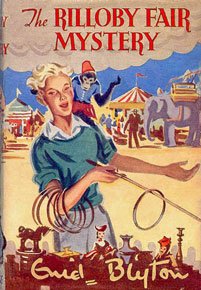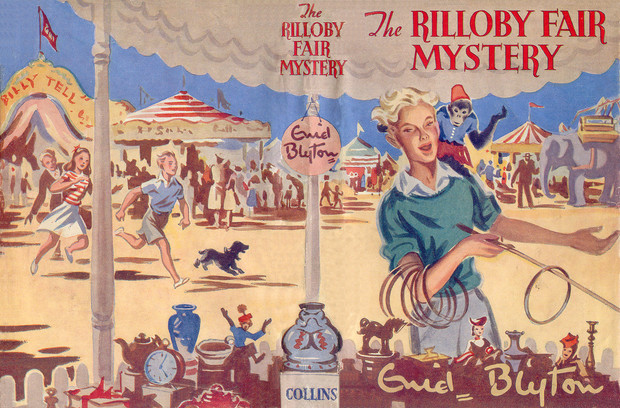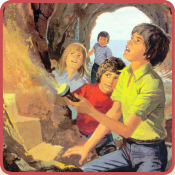
The Rilloby Fair Mystery

Book Details...
First edition: 1950
Publisher: William Collins
Illustrator: Gilbert Dunlop
Category: Barney Mystery Series
Genre: Mystery/Adventure
Type: Novels/Novelettes
Publisher: William Collins
Illustrator: Gilbert Dunlop
Category: Barney Mystery Series
Genre: Mystery/Adventure
Type: Novels/Novelettes
On This Page...
Reprints
1. 1967 Armada, illustrations by Gilbert Dunlop, cover by Mary Gernat
2. 1973 Armada, illustrations by Gilbert Dunlop, cover uncredited
3. 1979 Armada, illustrations by Gilbert Dunlop, cover by Peter Archer
4. 1986 Armada, illustrations by Gilbert Dunlop, cover uncredited
5. 1990 Armada, illustrations by Gilbert Dunlop, cover uncredited
6. 1993 Armada, not illustrated, cover uncredited
7. 1997 Collins, not illustrated, cover by Piers Sanford
8. 2003 Award, illustrations and cover by Eric Rowe
2. 1973 Armada, illustrations by Gilbert Dunlop, cover uncredited
3. 1979 Armada, illustrations by Gilbert Dunlop, cover by Peter Archer
4. 1986 Armada, illustrations by Gilbert Dunlop, cover uncredited
5. 1990 Armada, illustrations by Gilbert Dunlop, cover uncredited
6. 1993 Armada, not illustrated, cover uncredited
7. 1997 Collins, not illustrated, cover by Piers Sanford
8. 2003 Award, illustrations and cover by Eric Rowe

Wraparound dustwrapper from the 1st edition, illustrated by Gilbert Dunlop

1st German edition published by Blüchert Verlag in 1961,
illustrated by Nikolaus Plump with the title Riddle of the Green Hand
German: Rätsel em die grüne Hand
French: Le Mystère des Gants Verts
Dutch: Robbert Jan en het geheim van de Groene Hand
Spanish: Misterio en la Feria
Portuguese: O Mistério da Feira de Rilloby
Latvian: Rilobijas gadatirgus noslepums
Icelandic: Radgatan a Rofabae
Slovakian: Skrivnost Tolpe Zelena Roka
Brief Summary by Robert Houghton: A visit from pompous Great Uncle Robert, a travelling fair, the intriguing story of the Green Hands Gang and mysterious thefts in the night all combine to make a second wonderful mystery for Roger, Diana, Snubby and Barney the circus boy. How on earth does a thief manage to get through locked doors and windows with bars to steal valuable papers? The four children, along with Loony the dog and Miranda the monkey are determined to find out.
Full Review (This may contain spoilers):
Anita Bensoussane's Review
The Rilloby Fair Mystery differs from The Rockingdown Mystery in that it is a detective story rather than an adventure book, having more in common with the Find-Outers series than the Famous Five. Blyton presents us with a brilliant and truly puzzling mystery which is tightly-plotted, sparkling with humour and littered with curious clues and red herrings that keep the reader guessing right to the end.
Snubby is staying at the house of Roger and Diana's parents (Richard and Susan Lynton) for the Easter holidays, together with Great-uncle Robert, an elderly man who studies rare documents. The contrast between Snubby and the old gentleman makes for some dramatic moments: "Great-uncle Robert was so old and polite and pompous, correct in every way — and Snubby was so very much the opposite, cheeky, idiotic and unexpected in all he did."
Valuable documents have been stolen from various buildings — seemingly through locked doors and windows — and Roger, Diana and Snubby have reason to believe that the robberies may be the work of someone from the travelling fair where Barney runs the hoopla stall. Knowing that the fair is to visit Rilloby, near their home, they persuade Great-uncle Robert to take them to Marloes Castle, where there are collections of old papers and stuffed animals, as they suspect that the thieves may strike there next. Whilst there, the children notice two men, one of whom is remarkably hirsute, examining the papers.
The children plan to watch Marloes Castle each night but, on the second night, Snubby goes alone as the others have food-poisoning from eating sausage sandwiches at the fair. After seeing a black shadow scaling the walls of the building, Snubby, who has hidden in a bush, cuddles up to Loony and falls asleep. On awakening, he comes across scores of gleaming eyes in a dell, and flees in terror.
The next day the newspapers report that there has been a robbery at Marloes Castle — but this crime is even more puzzling than the others. No papers were stolen but stuffed animals were removed from the building and left in the grounds (hence the gleaming eyes!) It appears that the intruder entered through locked doors and windows.
The crime is baffling — until we eventually discover that all the robberies were committed by Burly, a chimpanzee from the fair. He was trained to steal by Tonnerre, the owner of the fair. Using a magnifying-glass to avoid arousing suspicion, the hairy man whom the children saw on their first visit to Marloes Castle would mark valuable papers with a substance that smelt. Burly would then climb the walls of a building at night, come down the chimney and steal the documents, knowing which ones to take by the smell. However, Burly's fondness for toy animals meant that, at Marloes Castle, he was distracted by the stuffed creatures on display. He took the animals instead of the papers but, unable to carry them out of the grounds, was forced to abandon them in the dell.
Those are the bare bones of the plot, but there are many other details that complicate and enrich the narrative. Snubby and Great-uncle Robert first meet on the train on their way to the Lyntons' and fall into conversation, neither of them realising to whom they are speaking. Great-uncle Robert tells Snubby that he has just come from a place (Chelie Manor House) where important papers were stolen from a locked room. Thinking the old man gullible, Snubby invents a story of his own, involving an atom-bomb plot by the Green Hands Gang. He claims that members of the Gang, who wear green gloves, have been after him since he stumbled on their secret, as they can use boys in their experiments. This invention of Snubby's plagues him when Great-uncle Robert becomes convinced that the fictitious Green Hands Gang must be behind the robberies, especially when a green glove proves to be a bona fide clue! The boy spends much of the book hiding from Great-uncle Robert to avoid having to answer awkward questions.
When discussing The Rockingdown Mystery, I mentioned that Rockingdown Hall reminded me of Edgar Allan Poe's House of Usher. Reading The Rilloby Fair Mystery, Poe springs to mind once again as the crime committed at Marloes Castle has something in common with the crime committed in Poe's "The Murders in the Rue Morgue" (Tales of Mystery and Imagination.) The learned man who narrates "The Murders in the Rue Morgue" is interested in rare books and leads a secluded life, either reading, writing or engaged in intelligent conversation with his friend, Dupin. Great-uncle Robert too is learned, studies old documents, values his solitude and frequently retires to the study, ostensibly to write his memoirs (though what he actually does is sleep!) Like many of Poe's characters he suffers from a nervous disposition, having felt too frightened to remain at Chelie Manor House after the robbery.
In both Poe and Blyton, an apparently illogical crime is committed. "The Murders in the Rue Morgue" concerns the murders of a mother and daughter in a room with locked doors, closed windows and a narrow chimney. The strangled body of the daughter is found pushed up the chimney, while the body of the mother, with head almost severed, is discovered in the back yard. The room is in disarray — yet precious gold and silver items have been left behind.
In The Rilloby Fair Mystery, stuffed animals are taken from a room with locked doors, fastened, barred windows and a narrow chimney, only to be left in the grounds, while rare documents remain untouched.
There is speculation in both stories that the criminal is a madman. The two crimes appear motiveless and would have required an unusual degree of agility on the part of the intruder. The answer in both cases is that the crime was perpetrated by an ape — an orang-utan in "The Murders in the Rue Morgue" and a chimpanzee in The Rilloby Fair Mystery.
In Poe's tale, Monsieur Dupin, a master of deduction, solves the mystery of the murders by analysing the facts. This is also the way Fatty works in Blyton's Find-Outers series. However, Roger and the others fail to solve the mystery of the robbery until Burly returns to Marloes Castle, miserable at having had to leave the stuffed animals behind, and re-enacts the crime in front of them.
As Blyton is writing for children, it is fitting that her book should deal with robbery rather than murder. As usual, she succeeds in creating an exciting, intriguing story without resorting to blood and gore. In a letter to Mr S. C. Dedman, a librarian, she wrote that children "know that they will never find anything wrong, hideous, horrible, murderous or vulgar in my books, although there is plenty of excitement, mystery and fun." (Enid Blyton — The Biography by Barbara Stoney, Appendix 6.)
We learn more about Mr and Mrs Lynton in this book, the former being a stereotypical middle-class father of those days — a remote figure who has little time for the children and rarely talks to them except to discipline them. In the first page and a half he speaks to Roger "impatiently," glances at him "irritably," snaps at him and glares at him. When Diana comes down to breakfast late, and starts arguing with Roger, Mr Lynton gives "an exasperated click" and leaves the room. It is left to his wife to mollify everyone and smooth things over. All this upset — yet Roger and Diana have only just returned from boarding-school! Confusingly, the title of Chapter 1 is "First Day of the Holidays," whereas Mrs Lynton states, a few paragraphs into the book: "It's only the second day of the holidays."
We see the children's father in a more attractive light later on, when he welcomes Barney to the house, saying: "Any friend of Roger's is a friend of mine," and Roger thinks: "Good old Dad! He might be hot-tempered and strict and all the rest of it — but he had the right thoughts and feelings every time." Mr Lynton obviously expects his children to learn by observing him, rather than by interacting with him. It's fortunate that Barney sees the positive side of Mr Lynton — otherwise he may have second thoughts about continuing with his quest to find his own father!
Once again, it's of interest to note features of Enid Blyton's style of writing. Blyton's fondness for animating objects is illustrated by the following sentence describing the Lyntons' garden: "Daffodils danced at the edges of the lawn, and wallflowers shook the scent from their velvet petals." Her love of experimenting with sounds — including rhyme, alliteration, assonance and onomatopoeia — is apparent throughout the book, for example when Mrs Lynton wonders what Great-uncle Robert will say when he finds the garden "full of yells and yelps, howls and growls, and screaming children," and in the reaction of Snoek the cat (called Sardine in later editions) to Miranda the monkey: "She went off like a firework, fizzing and hissing and spitting, her tail three times its size." Loony's energetic nature leads to his being compared to "a cannon-ball" and "a streak of black lightning," but the dog also has a more solemn side, as we realise when Blyton talks of "his long ears drooping like a judge's wig at each side of his head." Great-uncle Robert describes the room at Marloes Castle as "a peaceful place," just minutes before Burly the chimpanzee comes down the chimney — this kind of ironic comment occurs frequently in Blyton. There are the usual references to characters from fairytale or legend too. Sharp-tongued Old Ma looks like "a witch" as she stirs something in a big iron pot over a fire, while her grandson, Young 'Un, resembles "a hobgoblin." Interestingly, collections are a recurring theme. Not only do we have collections of rare documents and stuffed animals, but Burly's collection of soft toys, Tonnerre's tiny carved ivory statues and Diana's autographs. Even Loony collects mats and brushes!
The Rilloby Fair Mystery, more than any other title in this series, has humour in abundance. At the fair, Old Ma calls Snubby "Loony" and his dog "Snubby," and the children delight in puns, with Snubby referring to the chimps as "champs" and Roger adding that Snubby is "a champion chump." Blyton allows the children to be remarkably cheeky to adults. When Mr Lynton snaps: "Don't they teach you manners at school?" Roger replies: "No. They think we learn them at home," while Diana dares to ask: "Why is Dad so mouldy, Mother?" There is farcical comedy near the end of the book, when Burly is being chased through the grounds of Marloes Castle by Loony and Miranda, with Barney and Snubby in hot pursuit, and a policeman bringing up the rear. This is classic comedy, mirroring the episode in Chapter 11 when Great-uncle Robert is shocked at the sudden appearance of a monkey in his bedroom (he has not yet been introduced to Miranda), followed by Snoek and Loony, and finally by Roger, who asks the bewildered old gentleman if he has an old pair of shoes "for a friend of mine who's come for supper." Such goings-on resemble scenes from a play, as does the breakfast scene in Chapter 1. In fact, the whole book, with its comic episodes, misunderstandings between the characters, lively dialogue and elements of a traditional whodunnit, is full of dramatic potential.
Just like the Famous Five and the Five Find-Outers, Roger, Diana and Snubby are held up as examples to other children, with boys and girls from other walks of life either aspiring to their values, or failing to grasp them. Barney visits the Lyntons one Sunday when they have just returned from church and comments that he too would like to attend church: "He wanted to do everything these friends of his did, if he could." At the fair, when Young 'Un invites Snubby to help himself to a prize which he hasn't won, Snubby refuses but Young 'Un "didn't understand it in the least. He didn't seem to know what honesty meant where that kind of thing was concerned." Living hand-to-mouth, it's unlikely that Young 'Un would say no to anything offered to him and he cannot comprehend Snubby's refusal to accept the prize. Towards the end of the book, Barney, chasing Burly through the grounds of Marloes Castle, ignores a policeman who commands him to come to the police station for questioning. We can be sure that the other three children would never disobey the police like that — but then we have to remember that Barney was brought up in the circus and that circus and fair folk distrust the police (in Blyton books, anyway!)
Some of the stereotypical attitudes discussed above would not be acceptable in children's fiction today — and neither would the fact that one of the prizes to be won at Barney's hoopla stall is a packet of cigarettes! Most disturbing of all, Roger, the supposed naturalist, who expressed an interest in badger-watching in The Rockingdown Mystery, is quite happy to look at the stuffed animals on display at Marloes Castle. These include a rare albino badger which the lodge-keeper caught himself, as he tells the children proudly. The children's only criticism is that the animals are moth-eaten and have been carelessly stuffed!
In The Rockingdown Mystery we came across a fraudulent tutor — a device that had already been used in Five Go Adventuring Again. The Rilloby Fair Mystery features a chimpanzee which has been taught to steal important papers — an idea that Blyton was to reuse in Five Are Together Again. The latter is not a patch on The Rilloby Fair Mystery, however, being slow-paced, poorly-plotted and riddled with errors and inconsistencies. Blyton refers to characters from her circus books in The Rilloby Fair Mystery as well — Old Ma relates tales of circus and fair folk she has known, naming characters who are familiar to us from Come to the Circus (1948) and the Galliano's Circus books.
The Rilloby Fair Mystery is the perfect showcase for Snubby, who somehow contrives to be a thoroughly likeable pest. Although all four children have important parts to play in the story, Snubby is given the most prominence. Partly because of his cheek and cheerfulness, The Rilloby Fair Mystery is a real tonic and is the Blyton title I'd choose as a pick-me-up if I were ill or feeling down. Like the cooks and housekeepers in this series, I've got a soft spot for Snubby so I'll let him have the last word (as he does in most of the books!) Besides, I can't help but agree with him when he asserts, in the penultimate chapter: " — if you want a first-class mystery, well, you couldn't have a better one than the one to do with Rilloby Fair." These illustrations are hidden by default to ensure faster browsing. Loading the illustrations is recommended for high-speed internet users only.








